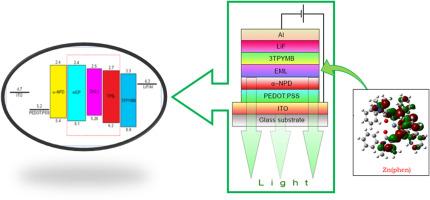Photo-and electroluminescent properties of mixed ligand zinc complexes for organic electroluminescent device applications
IF 4.2
3区 材料科学
Q2 MATERIALS SCIENCE, MULTIDISCIPLINARY
引用次数: 0
Abstract
Two Schiff base mixed ligand 4-[(N(2-hydroxy-1-naphthalidene)amino)antipyrine]zinc and 1,10 phenanthroline mixed ligand Schiff base zinc complexes were synthesized and characterized using 1H and 13C NMR, mass spectroscopy, elemental analysis, IR and UV–vis spectra. The thermal stability of compounds was characterized by TGA and its glass transition temperature was determined by the DSC method. Photoluminescence spectra show the emission peaks of both complexes lie in the 450–550 nm blue-green region. These two zinc complexes were used as a dopant material for mixed host materials with a concentration of 8 %. A series of devices having mixed host materials (mCPx:TPBI1-x) with the concentration of x = 0,1/4,1/2 and 3/4 have been developed. The concentration of both host materials was equal. The maximum luminance, current and power efficiency of the devices with zinc complex Zn(L) can reach up to 5516 cd/m2, 4.4 cd/A and 3.52 lm/W which are improved by introducing phenanthroline mixed ligand in the zinc complex Zn(phen). These results show that by changing the concentration of host material and introducing mixed ligand in the zinc complex can broaden the recombination zone and also balance the charge carrier in the emissive layer.

有机电致发光器件中混合配体锌配合物的光电致发光性质
合成了两种希夫碱混合配体4-[(N(2-羟基-1-萘)氨基)安替比林]锌和1,10菲罗啉混合配体希夫碱配合物,并利用1H和13C NMR、质谱、元素分析、IR和UV-vis光谱对其进行了表征。用热重分析仪表征了化合物的热稳定性,用DSC法测定了化合物的玻璃化转变温度。光致发光光谱显示,这两种配合物的发射峰位于450 ~ 550 nm的蓝绿色区域。将这两种锌配合物作为掺杂材料,在浓度为8%的混合寄主材料中使用。开发了一系列混合基质材料(mCPx:TPBI1-x),浓度分别为x = 0、1/4、1/2和3/4的器件。两种主物质的浓度相等。锌配合物Zn(L)器件的最大亮度、电流和功率效率分别可达5516 cd/m2、4.4 cd/A和3.52 lm/W,通过在锌配合物Zn(phen)中引入菲罗啉混合配体提高了器件的亮度、电流和功率效率。结果表明,通过改变载体物质的浓度和在锌配合物中引入混合配体,可以拓宽复合区,并平衡发射层中的载流子。
本文章由计算机程序翻译,如有差异,请以英文原文为准。
求助全文
约1分钟内获得全文
求助全文
来源期刊

Optical Materials
工程技术-材料科学:综合
CiteScore
6.60
自引率
12.80%
发文量
1265
审稿时长
38 days
期刊介绍:
Optical Materials has an open access mirror journal Optical Materials: X, sharing the same aims and scope, editorial team, submission system and rigorous peer review.
The purpose of Optical Materials is to provide a means of communication and technology transfer between researchers who are interested in materials for potential device applications. The journal publishes original papers and review articles on the design, synthesis, characterisation and applications of optical materials.
OPTICAL MATERIALS focuses on:
• Optical Properties of Material Systems;
• The Materials Aspects of Optical Phenomena;
• The Materials Aspects of Devices and Applications.
Authors can submit separate research elements describing their data to Data in Brief and methods to Methods X.
 求助内容:
求助内容: 应助结果提醒方式:
应助结果提醒方式:


